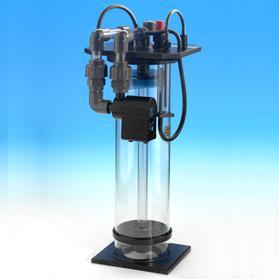Deltec Calcium Reactors are fitted with a pH probe holder, (except PF509), however we do not believe that you need to use a pH controller to get the most out of the unit.
In fact we find that you get better results if you do not use a pH controller.
Calcium reactors work by reducing the acidity, pH of the water passing through it using CO2 until it dissolves the calcium carbonate which is held inside. This breaks down the media into calcium ions and carbonate ions both of which are required for growth of corals and buffering of the water.
Setting up the Reactor
Having installed the equipment according to the instructions you will need to balance the reactor to the demands of your aquarium.
The reactor balances 3 parameters which are interlinked and all affect the calcium output from the reactor.
- Water flow rate through the reactor.
- CO2 bubble rate.
- Operation time for the reactor.
For smaller reactors such as the PF509 start with a drip rate through the reactor of approximately 1 drip per second. Match this with a CO2 bubble rate through the reactor of 1 bubble per second. These levels should be increased in relation to the size of the reactor and amount of media that the reactor holds as you go up in the series up to a constant unbroken dribble from the PF1001.
After running at the starting level for 1-2 hours use an accurate test kit to measure the Dkh of the water flowing out of the reactor as this gives a relative measurement of the calcium level of the water. Deltec reactors can achieve a dkh of up to 80 when set up and operating at their max however we would recommend that you start with a level of 45-50.
Test kits like those by Salifert will only measure up to 16 Dkh from the contents of one syringe. Add a second and so on to read 32 and 48 from this test.
If the Dkh is lower than 45-50 then increase the CO2 bubble rate and leave the reactor to stand for another 2 hours before re-testing. The reactor is now running as it should be and the third adjustable parameter comes in to play.
During the day, whilst the lights are on, the algae within the corals use CO2 from the water for photosynthesis which naturally raises the pH. Use of a calcium reactor lowers the pH due to CO2 addition and therefore the best time to use it is whilst the lights are on to reduce this effect.
The ideal time for the reactor to run is therefore 9-12 hours per day whilst the lights are on. Set the solenoid on your CO2 set to switch the gas on and off for the relevent period of time - do not change the flow of water through the reactor.
Check the Dkh and calcium within your aquarium on a daily basis. If this is tending to rise then you can further reduce the period that the CO2 is switched on.
If it is tending to fall then you can either increase the time that the CO2 runs or increase the amount of water passing through the reactor. This second option would be recommended for the reasons explained above but means going back to the first steps where you increase and adjust the CO2 until the Dkh comes back into line at 45-50.
As the corals grow you will find that you need to adjust the 3 parameters accordingly to maintain a balance.
Topping up the Reactor
Remember that the only difference between the various increasing models of calcium reactor is the volume of media that each holds. It therefore makes no sense to allow the level in the reactor to fall too far before you top it back up again.
